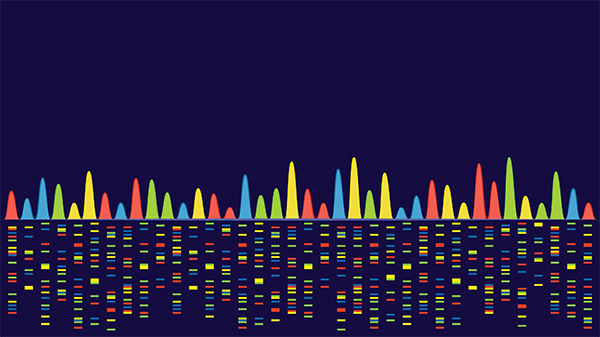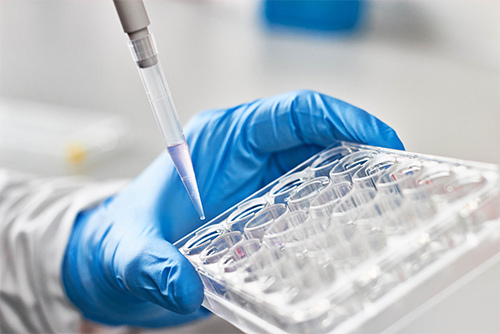High-Throughput Screening
In the field of modern biomedical research and drug discovery, high-throughput screening (HTS) has become widely used in drug development, molecular biology research, toxicology studies, and various other fields as an efficient screening technique. In this process, fluorescent dyes and probes play a critical role by providing real-time, sensitive, and quantitative detection methods, offering strong technical support for high-throughput screening. BOC Sciences, with its leading fluorescent dye and probe products and services, provides high-quality solutions for high-throughput screening. Whether in drug discovery, enzyme activity detection, or cell biology research, BOC Sciences can help researchers quickly and accurately complete high-throughput screening through its innovative technologies and products.
The Role of Fluorescent Labels in High-Throughput Screening

High-throughput screening (HTS) refers to the process of screening and analyzing large numbers of compounds, molecules, or cells in a short period using automation technology. It plays an important role in drug development, chemical research, and basic biology. Through high-throughput screening, researchers can quickly identify potential drug candidates or biological targets, greatly enhancing research efficiency. In this process, fluorescence labeling technology is commonly used to perform quantitative analysis of the screened compounds or biological processes, ensuring the efficiency and accuracy of screening. Their roles are mainly reflected in the following aspects:
- Sensitive Detection: Fluorescent dyes emit specific wavelengths of fluorescence when excited at particular wavelengths, and changes in fluorescence intensity between reactants and products can be monitored in real-time by automated equipment.
- Multiplex Detection: By selecting fluorescent dyes and probes with different wavelengths, researchers can perform multiple experiments simultaneously. For example, using various fluorescent probes to monitor different molecular targets at the same time greatly improves experimental efficiency.
- Real-time Monitoring: Fluorescent probes can monitor molecular interactions or biological reactions in real-time during dynamic experiments, thus providing real-time data and avoiding the delays and human errors associated with traditional methods.
- High-Throughput Automation: The use of fluorescent dyes and probes makes high-throughput screening not only possible at high precision but also fully automated, greatly improving experimental throughput and efficiency.
Advantages of BOC Sciences in Fluorescent Reagent Solutions
Leading Technology
BOC Sciences focuses on the development of fluorescent dyes and probes, with years of professional experience, offering advanced technologies and products to meet the high demands of precision and sensitivity in high-throughput screening.
Product Diversity
We offer a wide range of fluorescent labeling dyes, probes, and fluorescent protein dyes that cover various application fields, ensuring they meet diverse research needs.
Customization Services
Based on the specific needs of customers, BOC Sciences provides customized services such as fluorescent dye modification synthesis, fluorescent probe design, and multiplex detection probe design to help researchers solve different experimental challenges.
Quality Assurance
We provide rigorous quality control testing for all fluorescent labeling products, ensuring that each product meets high scientific standards to help clients achieve accurate and reliable results in high-throughput screening.
Fluorescent Label Solutions for High-Throughput Screening
BOC Sciences is committed to providing global researchers with high-quality fluorescent labeling solutions to support various high-throughput screening applications. We understand that high-throughput screening requires not only fast and accurate analysis but also ensures high sensitivity and stability in experiments. Therefore, the fluorescent dyes, probes, and fluorescent protein dyes we provide all feature excellent performance and can meet diverse research needs. Our product portfolio includes a variety of dyes suitable for different wavelength excitations, enabling clients to quickly obtain reliable experimental results in fields such as cell biology, enzyme activity detection, and drug screening. Whether screening a single target or performing multiplex target detection, our fluorescent labels offer highly sensitive signals, ensuring data accuracy and repeatability.
Fluorescent Labeling Dyes
Fluorescent Protein Dyes
- Green Fluorescent Protein
- Yellow Fluorescent Protein
- Red Fluorescent Protein
- mCherry
- mVenus
Fluorescent Probes
- Calcium Ion Probes
- pH Probes
- Reactive Oxygen Species (ROS) Probes
- Protein-Ligand Binding Probes
- Nitric Oxide (NO) Probes
Customization Services for High-Throughput Screening
In the high-throughput screening process, researchers often face diverse experimental demands and technical challenges. This requires fluorescent labels to not only possess high sensitivity and selectivity but also flexibility for customization to suit different screening platforms and experimental conditions. To address this, BOC Sciences offers a range of fluorescent labeling customization services to help clients design and customize fluorescent dyes, probes, and related products according to specific experimental needs. Whether modifying and synthesizing specific fluorescent dyes or developing probes for multiplex detection systems, we can provide tailored solutions. By working closely with clients, our R&D team can ensure product personalization and optimization while maintaining high performance. Our customization services not only meet the research needs of various fields, such as drug screening, enzyme activity detection, and gene analysis, but also provide support for seamless integration with existing experimental platforms, further improving the efficiency and accuracy of high-throughput screening.
Fluorescent Dye Modification Synthesis
For specific application requirements, BOC Sciences offers fluorescent dye modification synthesis services. By altering the structure of the dye, fluorescent dyes suitable for different experimental conditions can be obtained, such as those with stronger fluorescent signals, different emission wavelengths, or longer stability.
Custom Fluorescent Probe Design
According to the needs of researchers, BOC Sciences provides custom fluorescent probe design services. We can design highly specific and sensitive fluorescent probes based on the characteristics of target molecules or biological processes to ensure the efficiency and accuracy of experiments.
Multiplex Detection Probe Design
To achieve simultaneous detection of multiple targets, BOC Sciences offers multiplex detection probe design services. By selecting fluorescent probes with different wavelengths, researchers can simultaneously screen multiple targets in a single experiment, significantly improving experimental efficiency.
Comprehensive Fluorescent Labeling
BOC Sciences offers fluorescent labeling services for a variety of biological agents, including enzymes, antibodies, nucleic acids, proteins, and cells. Our fluorescent labeling services help accurately detect and analyze the activity and interactions of these biological agents in high-throughput screening.
Quality Control Testing Services for Fluorescent Labels
In high-throughput screening and other life sciences research, the quality of fluorescent labels directly impacts the accuracy and reliability of experimental results. To ensure the high quality and consistency of each fluorescent dye, probe, or protein labeling dye, BOC Sciences provides comprehensive quality control testing services. We have a deep understanding of the critical role that fluorescent labels play in various research applications, and therefore, we rigorously monitor the quality of all fluorescent label products to ensure they meet high-performance standards. Our quality control processes cover not only the physical and chemical properties of the products but also include a comprehensive evaluation of the stability, sensitivity, and specificity of the fluorescent labels, ensuring that each batch of products delivers accurate and reproducible experimental results. Through this series of detailed quality control tests, we help customers eliminate potential interference factors, providing stable support for critical research tasks such as high-throughput screening.
- Purity Testing: Using techniques such as high-performance liquid chromatography (HPLC), we ensure that the purity of fluorescent dyes and probes meets the specified standards.
- Fluorescent Performance Testing: We assess the excitation wavelength, emission wavelength, fluorescence intensity, and stability of the fluorescent dyes and probes to ensure their reliability under various experimental conditions.
- Background Noise Testing: We test the background noise in fluorescence signals to minimize it, thereby improving the signal-to-noise ratio of experimental data.
- Photostability Testing: Through repeated irradiation and light exposure tests, we evaluate the stability and durability of fluorescent labels, ensuring consistent performance over prolonged experiments.
- Reaction Specificity Testing: We ensure that fluorescent probes have good binding affinity and specificity for target molecules, avoiding signal interference from non-specific binding.
Advanced Analytical Platforms
- High-Performance Liquid Chromatograph (HPLC)
- Fluorescence Spectrophotometer
- Fluorescence Microscope
- Laser Scanning Confocal Microscope
- Spectrophotometer
- Flow Cytometer
- UV-Visible Spectrophotometer (UV-Vis)
- Photostability Tester
High-Throughput Screening Research Supported by Our Fluorescent Labels
The fluorescent label solutions provided by BOC Sciences offer key support for a variety of high-throughput screening applications and are widely used in drug discovery, enzyme activity detection, cell biology research, and other fields. With high sensitivity and selectivity fluorescent probes, we help customers quickly and accurately screen compounds or study biological processes, greatly enhancing experimental efficiency and data reliability.

Drug Discovery and Screening
Fluorescent labels are widely used in drug screening to quickly identify interactions between compounds and targets, providing real-time feedback. In high-throughput drug screening, fluorescent probes help efficiently screen large numbers of compounds and achieve high selectivity in detecting specific targets.
Enzyme Activity Detection
By fluorescently labeling substrates or inhibitors, researchers can monitor enzyme activity and reaction processes in real-time. The fluorescent labels provided by BOC Sciences assist in the efficient and accurate measurement of enzyme activity changes, supporting enzyme kinetics research and its applications.
Cell Biology Research
Fluorescent labels play an indispensable role in cell biology research by marking cells, subcellular structures, or specific proteins, providing precise visualization tools for cell function studies, molecular imaging, and real-time dynamic monitoring.
Receptor-Ligand Binding Detection
BOC Sciences' fluorescent probes can be used to detect receptor-ligand binding events. By fluorescently labeling, researchers can quantitatively analyze the affinity and binding rates of receptor-ligand interactions, supporting targeted therapeutic research for new drugs.
DNA/RNA Analysis
In genomic research, fluorescent labels are widely used for the quantitative analysis of DNA and RNA. By using fluorescent probes to label specific nucleic acid sequences, high-throughput gene expression analysis, mutation detection, and genomic scanning can be achieved.
FAQs About High-Throughput Screening
What is high throughput screening?
High throughput screening (HTS) is a method used in drug discovery and other biological research to rapidly conduct millions of chemical, genetic, or pharmacological tests. HTS allows researchers to evaluate large libraries of compounds, proteins, or nucleic acids for their biological activity in a short period. The technique uses automation, robotics, and advanced data analysis tools to handle and process numerous samples simultaneously, enabling the identification of potential drug candidates or targets quickly and efficiently.
How does high throughput screening work?
High throughput screening works by automating the process of testing a large number of compounds, biological molecules, or samples for their activity in a specific biological assay. The process involves preparing samples, usually in microplates, and exposing them to the test compounds. Automated equipment measures the biological response, often through changes in fluorescence, luminescence, or absorbance. The data is collected, analyzed, and compared to identify promising candidates. HTS systems can process thousands of compounds in a single day, making it an efficient method for drug discovery and other research.
What is high throughput screening in drug discovery?
In drug discovery, high throughput screening (HTS) is a technique used to identify potential drug candidates by testing large libraries of chemical compounds against biological targets, such as proteins, enzymes, or receptors. HTS helps accelerate the drug development process by rapidly identifying lead compounds that show desired biological activity. The process involves using automated systems to screen thousands to millions of compounds for their ability to interact with specific targets. HTS is crucial in early-stage drug discovery, allowing researchers to prioritize compounds for further testing and development.
Online Inquiry

